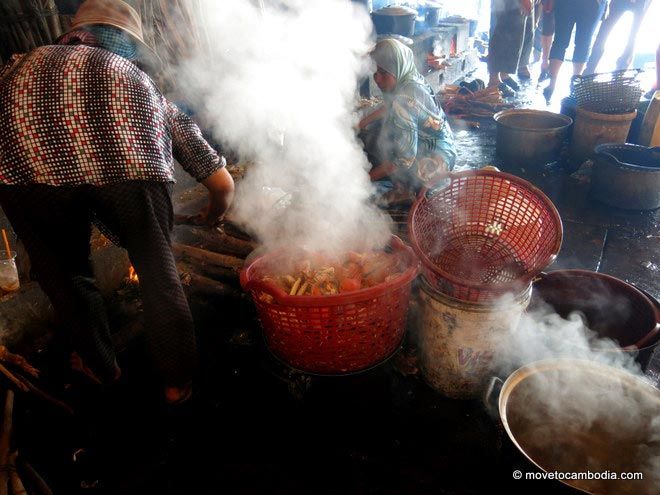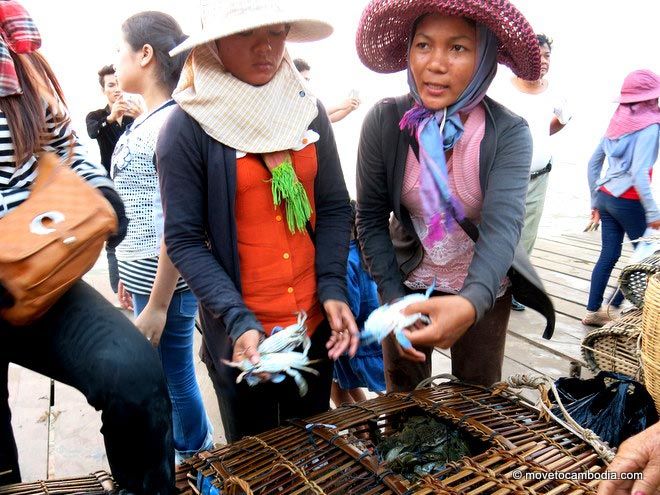For those of you who read my last post ‘Eating crab in Kep: The crab shack face-off‘ you may be curious about how one actually goes about buying crabs directly from the ladies at the Kep Crab Market. There’s no denying that the experience can be slightly intimidating, but the results—a giant steaming basket of crabs—are well worth it.

Throw yourself in the Kep Crab Market and be rewarded with a delicious lunch.
If you want to try your hand at buying live crabs in Kep, here are a few tips.
Be prepared to bargain. The first price you are offered will not be the going rate or the best price you can get. The difference is not huge, 5,000 riel ($1.25) or 10,000 riel ($2.50) at most, but you are expected to bargain. If you bargain in Khmer, you will get a better price. This is why learning numbers and shrieking “so expensive!” (t’lay na!) is the most important Khmer you can learn. If you can’t bear to bargain, there is a drink seller in the market who speaks English and is happy to help if you buy your beverages from him. You can identify him as the sugar cane juice stand closest to the cooking area and closest to the water—he has a green Apple logo on his stand and he doesn’t charge a markup to help (or not much).

Be prepared to bargain. This crab seller wanted 30,000 riel, we settled on 25,000 riel.
Prices vary. Keep in mind that prices can change dramatically day to day. So don’t assume you are getting ripped off just because you are paying more than someone else did last last week. A few days ago I was offered 20,000 riel ($5) for a kilo of small crabs and 30,000 ($7.50) for large crabs. Just a day later I paid 25,000 ($6.25) for a kilo of large crabs. But a day before I arrived during Chinese New Year, Lui paid 40,000 riel ($10) and the Canby Guide staff heard of prices going as high as 60,000, while a tuk tuk driver told me 80,000 was the going rate. Do any of these numbers matter? No. My point is just that prices vary wildly based on demand and availability so don’t be concerned if you don’t get the same prices you’ve read about. Have a smile on your face and keep the bargaining good-natured and you’ll get a good price.

Don’t be afraid to put your hands into the crab baskets and pick out the best of the bunch.
Inspect the crabs. From watching the locals, I learned that buying crabs is a hands-on affair. Decide if you want male or female crabs (females have delicious roe inside but males can have meatier claws) and learn how to identify them. Females have a bigger “apron” that is a dark color. Cambodians value the females more, but the Western palate doesn’t necessarily appreciate the roe and guts, so you may get a better deal on male crabs. Whichever you choose, you identify yourself as an engaged consumer by squatting down and putting your hands in the crab basket and picking the ones you want and rejecting the ones you don’t. If you don’t do this, essentially you send the message that you are prime for the taking. Watch a few locals buy crabs before you try it—even if they are buying kilos and kilos, they will inspect every one with a ridiculous amount of attention. Whether or not you have any idea what you are looking for, pretend that you do just to show you care. And ask for the big ones—kdam thom (big crabs). They’re easier to eat.

Boiling crabs and the Kep Crab Market makes for a great photo opp.
Get them cooked. It costs 3,000 riel ($0.75) to boil a kilo of crabs or 5,000 riel ($1.25) to stir fry them. The locals and the Move to Cambodia team usually go with boiling. The crabs are stunned and then boiled in salty water. Eaten in this method, the crab becomes the real star of the meal, and you can enjoy its natural crabby flavor to the fullest. Order some rice and chili sauce to accompany it—you’ll see women in the market selling both. The chili sauce is sold in water bottles for between 4,000 and 6,000 riel (the darker variety is tastier in my personal opinion). You can sit down to eat them at any of the drink-sellers’ tables if you buy drinks from them, or bring them back to your hotel if you prefer.
Take advantage of the photo opportunity. If you start pushing your way into the middle of someone else’s crab purchase to take photos with your iPad, you’re being a jerk. You’re getting in the way of someone else’s transaction if you butt in with your camera. But if it’s your transaction, feel free to take as many photos as possible. The cooking process with the steaming tubs of crabs make for wonderful photographs. You’ll get some great shots and no one minds because you’re buying their product.

Get involved and get yourself lunch.
Don’t be scared. I’m not going to lie, the first time you buy crabs at the Kep Crab Market you will probably intimidated. You will be swarmed by crab fisherwomen who will all be shouting at you in Khmer about how fantastic their crabs are. But the results are more than worth it. The crabs you buy on the pier will be fresher, tastier, and better value than the ones you’ll get at any of the nearby restaurants and you’ll get an authentic Cambodian experience in the process.
What is the name of the varietal of crabs at Kep? Thanks, Audre
To make this post complete after boiling how do they hand the crabs back to you? on a plate? whose plate? In a basket? Plastic bag? or what?
Usually a plastic bag. :)
We had lunch today in the crab market! It is the best way to eat the crab,it was 5£ x half kilo (big ones)with free cooking and at the end they gave us 3 extra crabs plus and we bought half kilo of medium shrimps (2000 riels to boil them). We bought 3 limes and a pinch of chili for only 1500 riels and eat them at the drinks stand!
it was just amazing.
my suggestion avoid the resturants they are overpriced
Hi Lina! I discovered your blog by chance when I was in Vietnam looking up some stuff about our next destination, Cambodia obviously :) We just arrived in Kep today and I have to say THANKS for all the wonderful info you put up! I’ll be pilchering your blog in the next few weeks I’m sure :) I’ll be going to the crab market tomorrow, can’t wait and I will definitely use your superhandy tips! Take care! Diewertje (Belgium)
Ooh…I am jealous! Have fun at the crab market. :)
[…] export, peppercorns. Kampot has also become popular with travelers for its close proximity to the crab haven of Kep as well as the motorbike ride up to Bokor Hill Station that offers spectacular views of the Gulf of […]
[…] ← Review: Mie Cafe, Siem Reap How to buy crab at the Kep Crab Market → […]